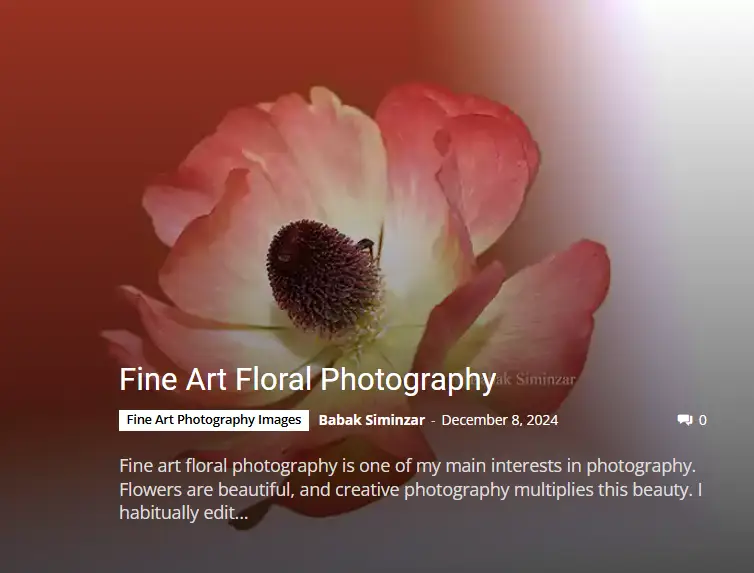It is not easy to define types of fine art photography clearly because they are not technical concepts but mental perceptions. This style is more related to aesthetics, imagination, and a particular way of looking at life. For this reason, its definition can be different based on each person’s tastes and perceptions.
Refer to Fine Art Photography to read more articles about this style.
Topics
What defines types of fine art photography?
Defining the types of fine art photography is not easy because they do not have clear boundaries, and only their concepts are different. But I tried to highlight the differences as much as possible.
Fine Art Portraiture
When photographing people on the street or at a party, it may be called street photography or just a record of memory. And so it is with portrait photography.
But if this portrait shows the subject with a special feeling in his face, such as sadness, bewilderment, or any other sense other than usual, it is no longer a standard portrait.
Please take a look at Famous Fine Art Photographers for more information.
This particular feeling should attract the audience’s attention and look unusual and remarkable, no matter what it is. Sometimes, the point is not in the portrait but in the place where the photo was taken, such as a room with unusual objects or a large room that shows the person alone.
In the fine art photography category, sometimes people’s clothes attract attention. They may be unusual, overly wrinkled, or distinctively colored. All these features can make a photo fit in the types of fine art photography category.
However, I will explain that this feature also introduces us to another type of fine art photography.
Conceptual photography
Conceptual photography is one of types of fine art photography, but not all fine art photography cases are part of concept photography.
In a sense, the photographer tries to convey his thinking to others. This method does not insist on using software, editing, or beautification. There is no imagination or dream.
The components of the image are completely real. The composition and placement of the elements distinguish it, and of course, the message and the thought hidden in the image play the most critical role.
As I mentioned before, fine art photography is a very mental attitude. It involves personal perception, and this property is more prominent in conceptual photography.
Conceptual photography has a meaning, but fine art photography may not have a specific meaning.

The next photo may seem normal to someone who lives in the same environment where it was taken. But for someone who grew up in a completely different environment, it can be a conceptual photo because each of them contains a message.
In this photo, a wooden fence surrounds a satellite dish. This is because using satellite TV reception equipment is prohibited in Iran.
As a result, the owner tried to hide it from 3 sides and left only the opposite angle open to the dish receives the waves.
As a result, the owner tried to hide it from three sides and left only the opposite angle open so that the dish could receive the waves. The message of this image could be to show the effect of the bans in Iran on the lives of the villagers and how they have adapted to these bans.
Still life Photography
Inanimate objects are usually used in this style. These items are often used daily, inexpensive, and put together in a specific manner.
Rely more on composition and recording moments to get an exciting image like putting food and dessert on the table or pouring a drink from a bottle into a glass. The main goal is to make the picture notable.
Fine Art Architectural Photography
If you take a picture from a certain angle of the building that creates a perspective view or shoot at night, and the light of the lamps changes the building color and effect in the dark, then you are entering the field of fine art photography from journalism.
This description of how to photograph a building was just an example. The point was that if photography moved away from mere reporting and information to an artistic approach, it could easily cross the line of journalism and reach fine art photography.
It is essential to photograph our hypothetical structure in a way that looks special, impressive, or strange. It occupies the mind somehow; it induces a feeling as if a man has never seen anything like it.
To achieve this goal, the subject must be changed during photography or editing to capture the attention of others unusually.
The next photo shows modern architecture. The building’s arches seem to be nested, and light shines intermittently on the ground from the many windows; combining these factors has given the image a unique appearance.
The following image shows the arches and symmetrical coloring combined with the floor’s reflection, which gives the photo a special effect.
Fine art landscape photography
Any action that can make a specific photo from a landscape photo can be considered.
Changing the angle and composition, focus, shooting time, and aperture settings can transform a standard landscape photo into a fine art landscape photo, which is one type of fine art photography. ( Please look at Landscape Photography Tips for Beginners to read more )
Fine art photography history
The first fine art photograph was exhibited in 1851. This trend more or less continued until the 1960s, when it became more popular. The photos first presented in this style were mainly about nudity, portraiture, and landscape.

Please take a look at Fine Art Floral Photography Gallery to view more photos
The famous masterpiece of Ansel Adams, The Tetons and the Snake River, who was himself a landscape photographer, is one of the favorite photos of this style.
Today, with digital photography and graphic software development, the element of beauty has received more attention. Pictures are often edited, and sometimes this editing is done highly. The concept is still an element of fine art photography, though different from a message or thought.
The photos mainly express a special feeling, sometimes they speak about a kind of vision. But the issue of aesthetics is more in the spotlight than ever before. Image editing is usually done so that the main subject draws the most attention to itself.
This excessive focus on editing has caused the images to move away from reality and look imaginary. So now, in addition to the message element, we have two other things, namely aesthetics and escapism.












